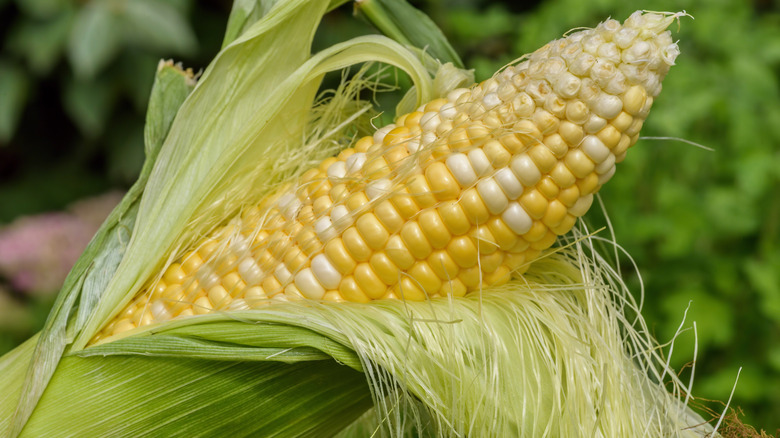Corn on the cob is America’s ninth most popular dish, according to YouGov. But it might rank even higher if not for the corn silk that clings tenaciously to the kernels — albeit for good reason: The sticky strands attract pollen from nearby male corn plants, conducting it toward the waiting female reproductive material within the growing plant, each kernel ultimately corresponding to a single pollen-laden silk strand.
Sure, you could skip over the work of removing residual strands by purchasing pre-shucked corn. But you’d be sacrificing a significant visual cue regarding the corn’s freshness — namely, the silk visible at the end of an unshucked ear. On the freshest corn on the cob, this “tassel,” as it’s known, will appear golden to light brown and feel satiny but slightly sticky to the touch, as opposed to dry or mushy. Moreover, the corn silk itself, is rich in nutrients, as the authors of a 2022 study point out, and we’ve got a bushel of ways you can use the corn silks rather than tossing them.
The easiest way to remove corn silk is by cooking corn in its husk — when cooked, the husk peels right off, along with the silk. The only wrinkle is that pesticides used in growing corn may be more concentrated in the silk and husk. So, if you don’t feel comfortable leaving the husk on during cooking, here are some easy ways to remove corn silk from uncooked corn in no time flat.
Use any bristly food-grade brush
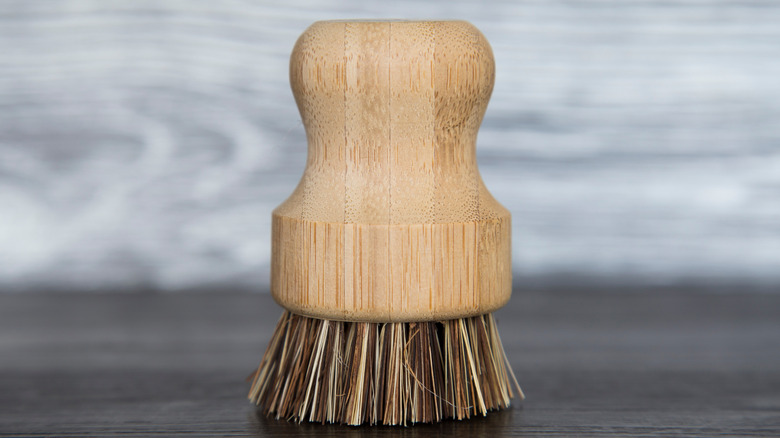
As you may have suspected, there’s a gadget out there designed specifically for removing corn silk. In most cases, it’s simply a food-grade circular brush with bristles on the inside. When you slip the ear of corn through the circle, the interior bristles tug on any residual strands. There’s nothing wrong with this method for corn silk removal — if you don’t mind the clutter of kitchen gadgets you don’t actually need.
But you needn’t go to the trouble of shopping for a specially-designated corn-silk-removing gadget, and you certainly don’t need to pay a premium price for what is, essentially, nothing more than a glorified veggie brush. In fact, even a clean toothbrush can be recruited for this same purpose.
To make use of the brush method, first, peel off the husk as you normally would. Then hold the brush firmly in the palm of one hand and swipe it over the ear vertically. Use a stroke that’s firm but still gentle enough so as not to puncture any kernels.
If you happen to end up with any leftover strands of corn silk — especially as you first become acquainted with this method, they should come off easily with a damp paper towel. Alternately, if you happen to have a gas stove, you can quickly pass the ear — and we mean really quickly — through the burner flame. That should singe off the stragglers, but not the corn, itself.
Use a gripper pad (the kind used for opening jars)
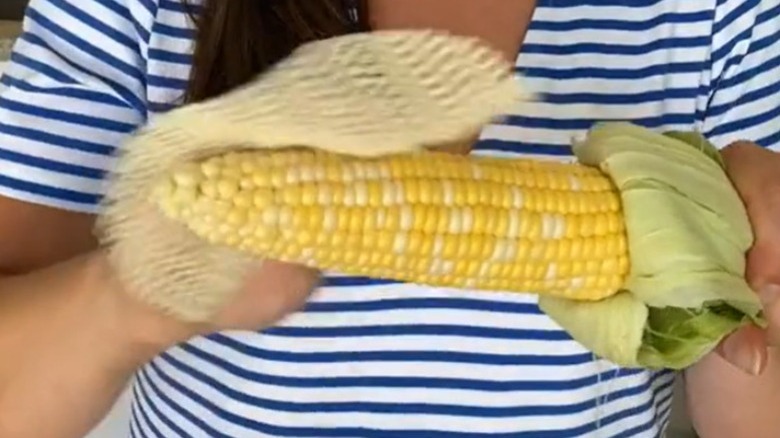
@southern_living/TikTok
You know that clever little “gripper pad” that you keep in your kitchen gadget drawer — the one that helps you open even the most stubbornly sealed jars? Well, the ingeniously simple reason it works is the magic of traction. And traction also happens to work wonders when it comes to removing sticky strands of corn silk from uncooked shucked corn cobs.
So, if you’ve got a gripper pad made of food-grade material, or a palm-sized scrap of any other thin but grippy material that you don’t mind touching your food, then you can use it for this purpose. And we think you’ll find it’s as simple and effective as the brush method described above.
Once you’ve shucked off the husk, take the pad in your hand — the same way you would if you were going to open a jar — and swipe up and down the length of the cob. Your grip on the ear should be firm, but not so firm that you run the risk of damaging the kernels through squeezing.
One thorough going-over or two should be all that’s necessary to rid the ear of all pesky silken threads. But if any do happen to remain, a damp paper towel should do the trick, as will briefly passing the cob through the flame of a gas stovetop burner, as discussed above.
A clean rubber glove will work a lot like the grippy pad, or maybe even better
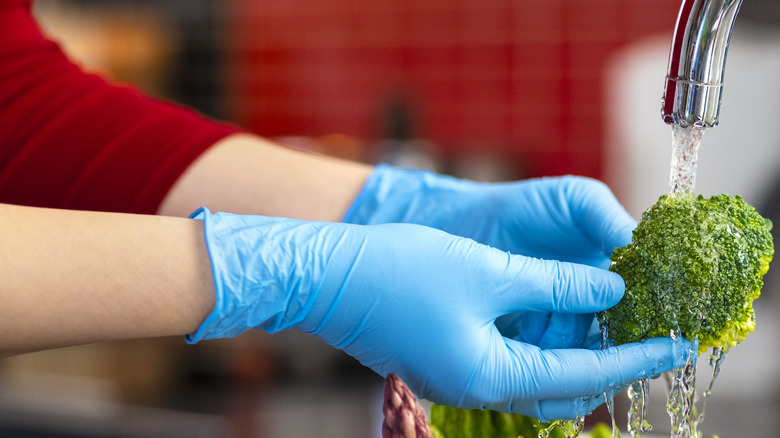
Even if you don’t happen to have a clever little grippy pad on hand for opening jars, you can still use traction to quickly and easily rid your corn on the cob of its silk without having to first cook the corn in its husk. All you will need is a clean pair of food-grade rubber gloves such as dishwashing gloves or food service handling gloves — the kind you might use to protect your hands when seeding chile peppers.
In fact, you can even use a clean pair of dog grooming gloves, assuming that you’re comfortable that they’re made of non-toxic material. Indeed, to the extent that the palm side is covered with tiny brush-like extensions, as many dog grooming gloves are, you may even find dog grooming gloves to be more effective than ordinary rubber gloves.
Simply shuck off your husks as you normally would, don your gloves, and grip the corn — with both hands. Use your hands as you would with the grippy pad, sliding them up and down the length of the ear of corn. Considering you’re using both hands, this method may prove even more effective than the grippy pad method.
But if any strands of corn silk do end up getting left behind, they can be easily dispatched with either a damp paper towel or a brief trip through a flame, as described above.
The rubber band method is our least favorite, but it does work
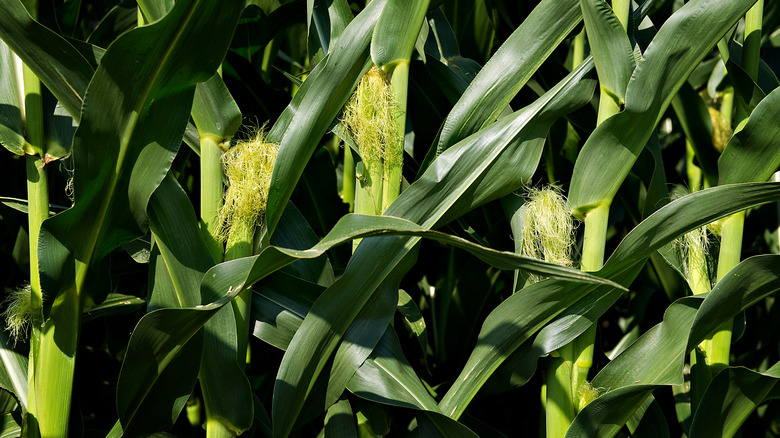
Bloomberg/Getty Images
If you don’t have a clean brush or a grippy pad handy, you can also try using a thick uncoated rubber band to remove corn silk. We’re talking about the food-safe kind that’s used for, say, holding together bunches of asparagus.
Start, as always, by shucking the corn. Then see if your rubber band fits snugly on the ear — but without constricting the kernels, which could damage them. If it does, then gently slide the band up the length of the ear and then back down again to catch as many strands as possible. If the rubber band is too big to fit snugly, then wrap it around either of your four fingers or your thumb and forefinger, whichever is more comfortable. In either case, spread your fingers out as needed to pull the band taut, and slide the band up and down the length of the ear.
Do note, however, that while the rubber band method of removing corn silk can be very effective, it’s not quite as easy and foolproof as the others we’ve been discussing. It’s likely you’ll need to go over the ear with a damp paper towel or pass it through a flame to remove the last stubborn strands. If not, well, then even better!
A mere 30 seconds in the microwave will yield you silk-free corn on the cob

Even if you don’t want to cook your corn before shucking it, you can still let your microwave oven do most of the work for you. All it takes is a mere 30 seconds of heating in the microwave, which still leaves plenty of time for actual cooking.
To use the microwave method, use a sharp knife to slice off the knobby part of the stem end of your corn cob. Place the rest of the corn cob — husk, tassel, and all — into the microwave, and set it to 30 seconds at high power. Afterward, wait until the ear has cooled down to a temperature that’s comfortable to the touch, and then simply peel back the husk. As you do, the silk should come off right along with it.
If any corn silk does happen to be left behind, it will have softened and become significantly less sticky via the concentrated heat from the microwave. That means you’ll be able to easily wipe it away with a damp paper towel or by passing it through a flame, as previously discussed.



